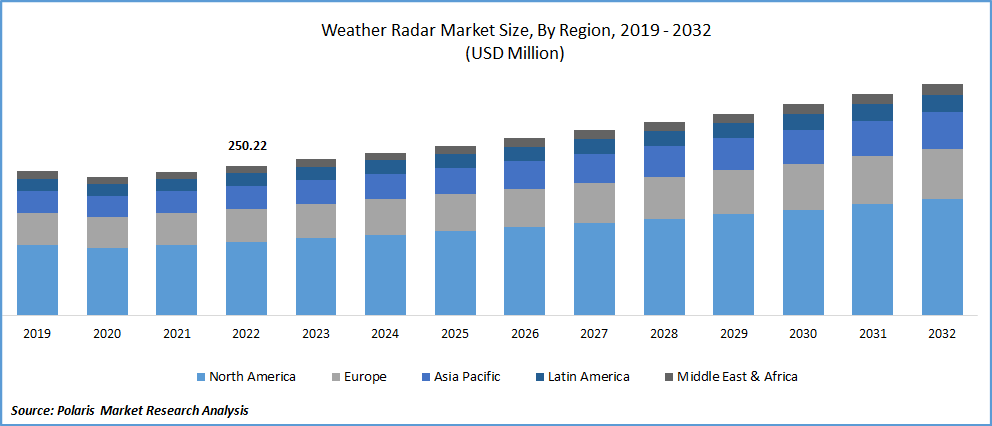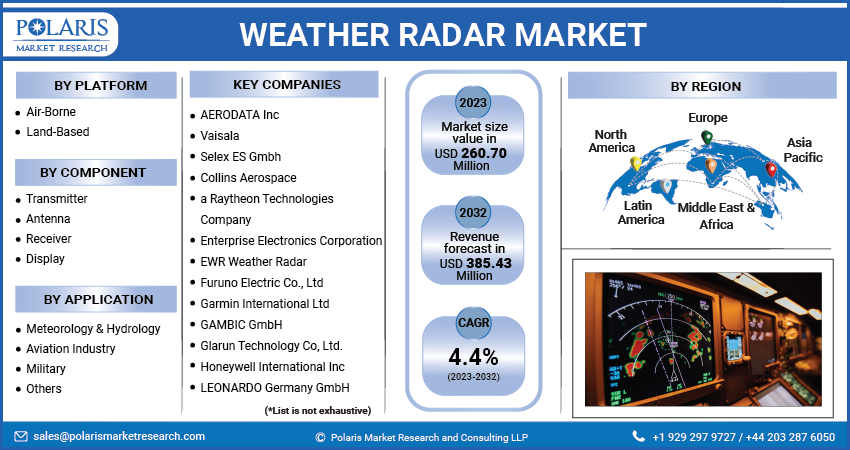
Weather Radar Market Share, Size, Trends, Industry Analysis Report, By Platform (Air-borne, and Land-Based); By Component; By Application; By Region; Segment Forecast, 2023 - 2032
- Published Date:May-2023
- Pages: 119
- Format: PDF
- Report ID: PM3196
- Base Year: 2022
- Historical Data: 2019-2021
Report Outlook
The global weather radar market was valued at USD 250.22 million in 2022 and is expected to grow at a CAGR of 4.4% during the forecast period. A weather radar is used to determine atmospheric climatic conditions. This radar is commonly used for meteorological and climatological purposes. A weather radar is a pulse-doppler radar which identifies the motion and strength of rain, snow, or hail to evaluate and deliver information on weather conditions. The data obtained by the radar system is used in a variety of businesses, including agriculture, tourism, public safety, the aviation sector, and others. Weather radars aid in the monitoring of bigger weather systems, such as those used to monitor hurricanes.

Know more about this report: Request for sample pages
The need for weather radar systems is increasing as the frequency of natural disasters such as thunderstorms, cyclones, ice storms, and snowfalls increases. As a result, demand for such radar systems is considered in the aviation industry, as these regulate aircraft safety and weather-related activity planning.
One of the factors contributing to the increase in the need for weather radar is the increased adoption of new radar by weather forecasters to improve weather prediction. Climate change increases the likelihood of severe weather events such as droughts, floods, and heat waves. Weather radar systems give qualitative and quantitative information about the atmosphere and are employed in weather forecasting, hydrological applications, and severe storms.
Furthermore, these radars are commonly employed in climate research, which necessitates ground verification for satellite-based worldwide precipitation measurements. These radars capture data, which is then processed to determine changes in the climate and surroundings.
In recent years, aircraft personnel and passengers have been wounded as a result of intense turbulence created by the flight. Other incidents, such as fuselage damage caused by hail storms, were also documented. It has become vital to recognise and avoid severe weather conditions to fly comfortably and safely.
Furthermore, climate change has caused infrastructure and human lives to be destroyed. The increasing use of radar for weather analysis is likely to drive weather radar market expansion. However, Weather radar systems necessitate a highly skilled and experienced team to evaluate correct results and insights from collected data. Furthermore, the high expenses involved with conducting workforce training programmes are projected to impede the entry of new companies into this market. This, in turn, is likely to slow the growth of the market.
The COVID-19 epidemic has had a significant impact on the aviation industry. Due to the closure of countries and air travel, planes, airports, and big and minor component manufacturers suffered financial difficulties. New aircraft shipments have been cancelled or delayed, affecting the market for airborne radar systems. Because the airports are empty, the owners have delayed or postponed the procurement of modern air traffic control equipment. This market has been hit the hardest in Asia-Pacific.

For Specific Research Requirements, Request for a Customized Research Report
Industry Dynamics
Growth Drivers
An advanced technology demonstration (ATD) is a dual-polarized S-Band phased array specifically built to be used as a weather information radar. An ATD is made up of a flat panel with a large number of extremely small antennas that transmit radio waves and gather responses from atmosphere. The radar can be driven electrically using this phased array technique. ATD is the first radar to incorporate dual-polarization and phased array technologies. An ATD, using dual-polarization technology, may identify dry hail, snowfall, and clear air disturbance that conventional weather radar cannot capture.
Further, the rising adoption of advanced technology demonstration (ATD) as well as the development of technology-based weather radars are influencing the growth of the market over the forecast period. In September 2022, The Bureau of Meteorology (BoM) of Australia finalised the establishment of the dual-polarized Doppler weather radar at Richmond. In January 2019, The National Oceanic and Atmospheric Administration (NOAA), National Severe Storms Laboratory (NSSL) , as well as the Federal Aviation Administration (FAA), have collaborated to support the design and implementation of the Advanced Technology Demonstrator (ATD).
The ATD is a dual-polarization, electronics and communication engineering scanned array radar designed specifically to test a phased array radar's dual polarisation capability. This proof-of-concept phased array radar will be utilised to demonstrate calibration methods, dual polarisation performance, and weather and aviation surveillance that used a dual polarisation phased array radar. Therefore, market growth is rapidly seen in recent years.
Report Segmentation
The market is primarily segmented based on platform, component, application, and region.
|
By Platform |
By Component |
By Application |
By Region |
|
|
|
|
Know more about this report: Request for sample pages
The Antenna Segment is Expected to Witness the Fastest Growth over the Forecast Period
Due to technical improvements, antennas are expected to be the largest and fastest-growing segment. The radar antenna sends out radio wave pulses that bounce off any object in its path. The object sends a little portion of the wave's energy back to the receiver antenna, which is normally situated near the transmitter. The primary function of traffic radars is to detect vehicle speed. Furthermore, increased investment in the creation of antennas for smooth data transfer from weather radar is likely to promote market expansion.
The Air-Borne Segment Industry Accounted for the Highest Market Share in 2022
Airborne weather information radars are installed inside aircraft to provide data to the pilot, aircrew, and passengers regarding weather conditions, allowing them to avoid entering hazardous situations. As the radar system is necessary for the manufacture of each new aircraft, rising aircraft deliveries are likely to fuel the expansion of this market. The cause for the increased aircraft deliveries is the rapidly rising demand for air travel as various emerging countries' economies improve.
Because of the increased demand for air travel, airlines have been expanding their aircraft fleet, producing a strong demand for new aircraft. The increased demand for new aircraft has pushed up the need for airborne weather radars. Weather radars allow pilots to make more informed and timely judgements under adverse weather circumstances. It also provides information on the presence and strength of convective clouds along the aircraft's route, advising a change in route and lowering the chance of an aviation accident.
The Demand in North America is Expected to Witness Significant Growth
North America is predicted to dominate the market over the forecast period due to increased demand for new aircraft as air travel grows. The United States is a major aircraft production hub. As the impacts of climate change become more severe, the need for weather radars is rising in the United States. Flooding, storms, and other extreme weather disasters are becoming more regular, and as a response, people are searching for ways to safeguard themselves and their property.
In July 2022, Honeywell has granted Ontic an exclusive licence for the RDR4A/B Weather Radar Systems. To assure continuing customer service, Ontic will employ its existing locations and repair teams in the United States, Europe, and Asia. Weather radar can assist individuals track storms and decide whether they should evacuate or take other precautions. The aviation industry's market for weather information radar is predicted to expand substantially.
Asia-Pacific is expected to be the fastest-growing area throughout the projection period, owing to increased spending on aircraft manufacturing as well as increased spending by governments in countries such as India and China to protect against harsh weather. Furthermore, increased climate changes in the region as well as the installation of weather radars are likely to drive market expansion.
In September 2021, The India Meteorological Department announced that an X-band Doppler weather radar had been erected here to give better weather solutions to the residents of Jammu and Kashmir. The cutting-edge indigenous GPS-based pilot-sonde collects data in all weather situations with minimal human interaction and includes auto-detection of inflated launch and balloon rupture. Hence, these factors are predominately boosting regional growth.
Competitive Insight
Some of the major players operating in the global weather radar market include AERODATA, Inc, Anhui Sun Create Electronics., Beijing Metstar Radar Corporation, Collins Aerospace, Raytheon Technologies, Enterprise Electronics Corporation, EWR Weather Radar, Furuno Electric, Garmin International, GAMBIC, Glarun Technology, Honeywell International, LEONARDO Germany, Selex ES, and Vaisala.
Recent Developments
- In May 2022, ABS Jets has agreed to retrofit its Embraer Legacy commercial planes with Honeywell International Inc.'s IntuVueRDR-7000 weather radar. The RDR-7000 weather radar monitors the sky automatically from the floor to 60,000 feet, with a range of 320 nm. This could detect turbulence with considerably greater accuracy and over a wider range.
Weather Radar Market Report Scope
|
Report Attributes |
Details |
|
Market size value in 2023 |
USD 260.70 million |
|
Revenue forecast in 2032 |
USD 385.43 million |
|
CAGR |
4.4% from 2023 - 2032 |
|
Base year |
2022 |
|
Historical data |
2019 – 2021 |
|
Forecast period |
2023 - 2032 |
|
Quantitative units |
Revenue in USD million and CAGR from 2023 to 2032 |
|
Segments Covered |
By Platform, By Component, By Application, By Region |
|
Regional scope |
North America, Europe, Asia Pacific, Latin America, Middle East & Africa |
|
Key Companies |
AERODATA, Inc, Anhui Sun Create Electronics Co. Ltd., Beijing Metstar Radar Corporation Ltd., Collins Aerospace, a Raytheon Technologies Company, Enterprise Electronics Corporation, EWR Weather Radar, Furuno Electric Co., Ltd, Garmin International Ltd, GAMBIC GmbH, Glarun Technology Co, Ltd., Honeywell International Inc, LEONARDO Germany GmbH, Selex ES Gmbh, and Vaisala |
FAQ's
The weather radar market report covering key segments are platform, component, application, and region.
Weather Radar Market Size Worth $385.43 Million By 2032.
The global weather radar market expected to grow at a CAGR of 4.4% during the forecast period.
North America leading the global market .
Key driving factors in weather radar market are rising adoption of advanced technology demonstration (ATD).
